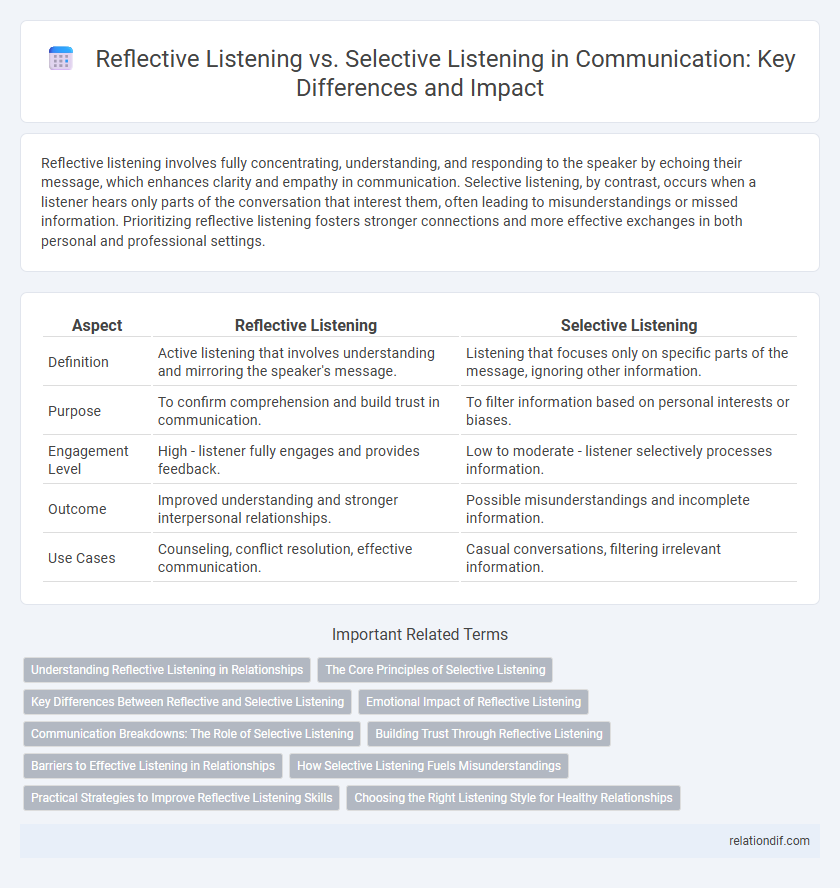Reflective listening involves fully concentrating, understanding, and responding to the speaker by echoing their message, which enhances clarity and empathy in communication. Selective listening, by contrast, occurs when a listener hears only parts of the conversation that interest them, often leading to misunderstandings or missed information. Prioritizing reflective listening fosters stronger connections and more effective exchanges in both personal and professional settings.
Table of Comparison
| Aspect | Reflective Listening | Selective Listening |
|---|---|---|
| Definition | Active listening that involves understanding and mirroring the speaker's message. | Listening that focuses only on specific parts of the message, ignoring other information. |
| Purpose | To confirm comprehension and build trust in communication. | To filter information based on personal interests or biases. |
| Engagement Level | High - listener fully engages and provides feedback. | Low to moderate - listener selectively processes information. |
| Outcome | Improved understanding and stronger interpersonal relationships. | Possible misunderstandings and incomplete information. |
| Use Cases | Counseling, conflict resolution, effective communication. | Casual conversations, filtering irrelevant information. |
Understanding Reflective Listening in Relationships
Reflective listening enhances relationships by actively focusing on the speaker's message and emotions, promoting empathy and clarity. Unlike selective listening, which filters information based on personal biases or interests, reflective listening validates the speaker's feelings and encourages open communication. This technique strengthens trust and reduces misunderstandings by ensuring both parties feel heard and understood.
The Core Principles of Selective Listening
Selective listening focuses on the core principles of filtering information based on personal interests, priorities, or biases while tuning out irrelevant details. It involves actively choosing specific messages to process, which can lead to misunderstanding or missed information if not managed carefully. This type of listening prioritizes efficiency and goal-oriented communication but risks overlooking critical context and nuances.
Key Differences Between Reflective and Selective Listening
Reflective listening involves actively understanding and paraphrasing the speaker's message to confirm comprehension, while selective listening focuses on hearing only specific parts of the conversation that interest the listener. Reflective listening enhances empathy and communication clarity by fully engaging with the speaker's intent, whereas selective listening risks misinterpretation by filtering information based on personal biases. Key differences include the depth of attention and intent: reflective listening seeks complete understanding, selective listening prioritizes partial, subjective information processing.
Emotional Impact of Reflective Listening
Reflective listening enhances emotional connection by validating the speaker's feelings and promoting understanding, which reduces misunderstandings and builds trust. It encourages open communication by mirroring emotions and helping individuals feel genuinely heard and supported. In contrast, selective listening often leads to misinterpretation and emotional disconnect, hindering effective interpersonal communication.
Communication Breakdowns: The Role of Selective Listening
Selective listening often leads to communication breakdowns by causing important messages to be ignored or misunderstood, disrupting the flow of effective interaction. This approach filters information based on personal biases, creating gaps in understanding and increasing the risk of conflict. Reflective listening, by contrast, fosters clarity and empathy, helping to prevent these breakdowns through active engagement and verification of the speaker's intent.
Building Trust Through Reflective Listening
Reflective listening fosters trust by showing genuine empathy and understanding, allowing the speaker to feel heard and valued. This approach contrasts with selective listening, which can cause miscommunication and erode confidence due to missed or ignored information. Consistently practicing reflective listening strengthens relationships and promotes open, honest dialogue in both personal and professional communication.
Barriers to Effective Listening in Relationships
Reflective listening minimizes barriers to effective listening in relationships by promoting empathy and confirming understanding, which reduces misunderstandings and emotional disconnect. Selective listening introduces obstacles by filtering information based on personal biases, leading to misinterpretation and communication breakdowns. Overcoming barriers requires conscious effort to engage fully and validate the speaker's message to foster trust and clarity.
How Selective Listening Fuels Misunderstandings
Selective listening often leads to misunderstandings by filtering information through personal biases, causing key details to be overlooked or distorted. This narrow focus prevents accurate interpretation of messages, reducing the effectiveness of communication. In contrast, reflective listening fosters clarity by encouraging full attention and feedback, minimizing errors caused by selective hearing.
Practical Strategies to Improve Reflective Listening Skills
Effective reflective listening requires focusing entirely on the speaker's message, restating their ideas accurately to confirm understanding, and avoiding premature judgments or interruptions. Practical strategies include practicing active observation of verbal and nonverbal cues, summarizing key points aloud, and asking open-ended questions that encourage elaboration. Regular feedback sessions and mindfulness exercises can enhance concentration and empathy, fostering deeper connections and clearer communication.
Choosing the Right Listening Style for Healthy Relationships
Reflective listening involves actively mirroring the speaker's message to confirm understanding and build trust, essential for nurturing healthy relationships. Selective listening, by focusing only on specific parts of a conversation, can lead to misunderstandings and hinder emotional connection. Choosing reflective listening as the primary communication style fosters empathy, reduces conflict, and enhances relationship quality.
reflective listening vs selective listening Infographic

 relationdif.com
relationdif.com